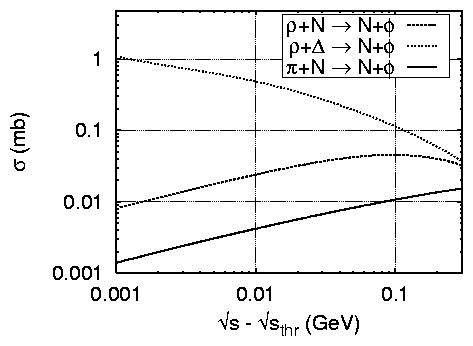| Cross Sections for f Meson Production in r Meson-Baryon Collisions B,A | ||||||||||||||||||||||||||||||||||||
|---|---|---|---|---|---|---|---|---|---|---|---|---|---|---|---|---|---|---|---|---|---|---|---|---|---|---|---|---|---|---|---|---|---|---|---|---|
| H.W. Barz, M. Zétényi1 | ||||||||||||||||||||||||||||||||||||
|
Recently f meson production was measured in subthreshold
Ni+Ni and Ru+Ru collisions by the FOPI collaboration at the
heavy-ion synchrotron at GSI Darmstadt [1].
The f meson yield found in these experiments is considerably larger
than the predictions of Boltzmann-Ühling-Uhlenbeck (BUU) calculations [2].
A possible explanation could be the existence of new f
production channels that have not been considered so far in BUU
calculations. Therefore, we study the f production cross sections in
r-N and r-D collisions.
The quantity |M |2 represents the squared matrix elements summed over the final and averaged over the initial spin and isospin states. These expressions read for the r-N channel
and for the r-D channel
Here, the incoming four-momenta are denoted by pr, pD and pN¢ while the pN and pf are the outgoing momenta. The factors Ai are given by ArN ® fN = (fpN Nfprf/mpmf)FpN N(pp2)Fprf(pp2) and ArD® fN = (fpN Dfprf/mpmf)FpN D(pp2)Fprf(pp2). Substituting the appropriate values for the coupling constants fi and the cutoff parameters appearing in the form factors Fi(pp2) and integrating Eq. (1) numerically over the angle we obtain the total cross sections. Their values are displayed in Fig. 1 as a function of the CM energy above threshold using the peak masses of the resonance states involved. For comparison we have included the cross section for the process p+N ® N+f [2]. The obtained cross sections for f meson production in r channels are much higher than that of the p-N channel, therefore the r-baryon channels can essentially contribute to f production in heavy-ion collisions despite their relative small abundances.

Fig. 1 Total cross section of f meson production in the reactions r+N ® N+f and r+D® N+f. For comparison the cross section for the process p+N ® N+f is also included. Note that the threshold for the r+D process lies in the incoming channel.
1
KFKI Budapest, Research Institute for
Particle and Nuclear Physics, H-1525 Budapest, POB 49,
References
[1] R. Kotte (FOPI collaboration), Proc. Int. Workshop XXVIII,
Hirschegg, Austria, 2000, p. 112 |
||||||||||||||||||||||||||||||||||||